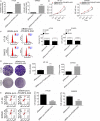Long non-coding RNA POU6F2-AS2 promotes cell proliferation and drug resistance in colon cancer by regulating miR-377/BRD4
- PMID: 32100443
- PMCID: PMC7171422
- DOI: 10.1111/jcmm.15070
Long non-coding RNA POU6F2-AS2 promotes cell proliferation and drug resistance in colon cancer by regulating miR-377/BRD4
Abstract
The aim of this study was to explore the molecular mechanism of lncRNA POU6F2-AS2 in proliferation and drug resistance of colon cancer. Total paired 70 colon cancer and adjacent normal tissues were collected from colon cancer patients. Colon cancer and normal colonic epithelial cells were purchased. POU6F2-AS2 was up- or down-expressed by vectors. LC50 of all cell lines before and after transfection with these plasmids was detected. qRT-PCR was used to detect the expression of POU6F2-AS2, miR-377 and BRD4 before or after transfection. In situ hybridization was also undertaken to detect the level of POU6F2-AS2. Different concentrations of 5-Fu (0, 1, 2.5, 5, 10, 20, 40 and 80 μg/mL) were used for 5-FU insensitivity assay. CCK-8 and crystal violet staining assay were used for detecting cell proliferation, and flow cytometry was used for identifying cell cycle distribution and apoptosis. In order to detect the fragmented DNA in apoptotic cells, TUNEL assay was used. RNA pull-down assay and luciferase reporter assay were used to verify the binding site. Rescue assay confirmed the subtractive effect of miR-377 inhibitors. POU6F2-AS2 was highly expressed in colon cancer, which was associated with clinical pathology. Up-regulated POU6F2-AS2 promoted cell proliferation and cell cycle of colon cancer cells. Overexpression of POU6F2-AS2 inhibited the expression of miR-377 and then up-regulated the expression of BRD4. Up-regulated BRD4 ultimately promoted cell proliferation and cell survival Down-regulated POU6F2-AS2 showed enhanced sensitivity of 5-FU. POU6F2-AS2 promoted cell proliferation and drug resistance in colon cancer by regulating miR-377/BRD4 gene.
Keywords: LncRNA POU6F2-AS2; cell proliferation; colon cancer; drug resistance; miR-377/BRD4.
© 2020 The Authors. Journal of Cellular and Molecular Medicine published by Foundation for Cellular and Molecular Medicine and John Wiley & Sons Ltd.
Conflict of interest statement
All authors declare that they have no conflicts of interest.
Figures







References
-
- Nicoli ER, Dumitrescu T, Uscatu CD, et al. Determination of autophagy gene ATG16L1 polymorphism in human colorectal cancer. Rom J Morphol Embryol. 2014;55:57. - PubMed
-
- Chen SC, Yen ZS, Wang HP. Ultrasonography in diagnosing colorectal cancers in patients presenting with abdominal distension. Med J Aust. 2006;184:614‐616. - PubMed
-
- Lee YC, Yang CN, Hsu T, Lu PJ. Abstract 1146: STK4 downregulation promotes tumor invasion/migration and is associated with poor prognosis in human colon cancer. Can Res. 2013;73:1146‐1146.
Publication types
MeSH terms
Substances
LinkOut - more resources
Full Text Sources

